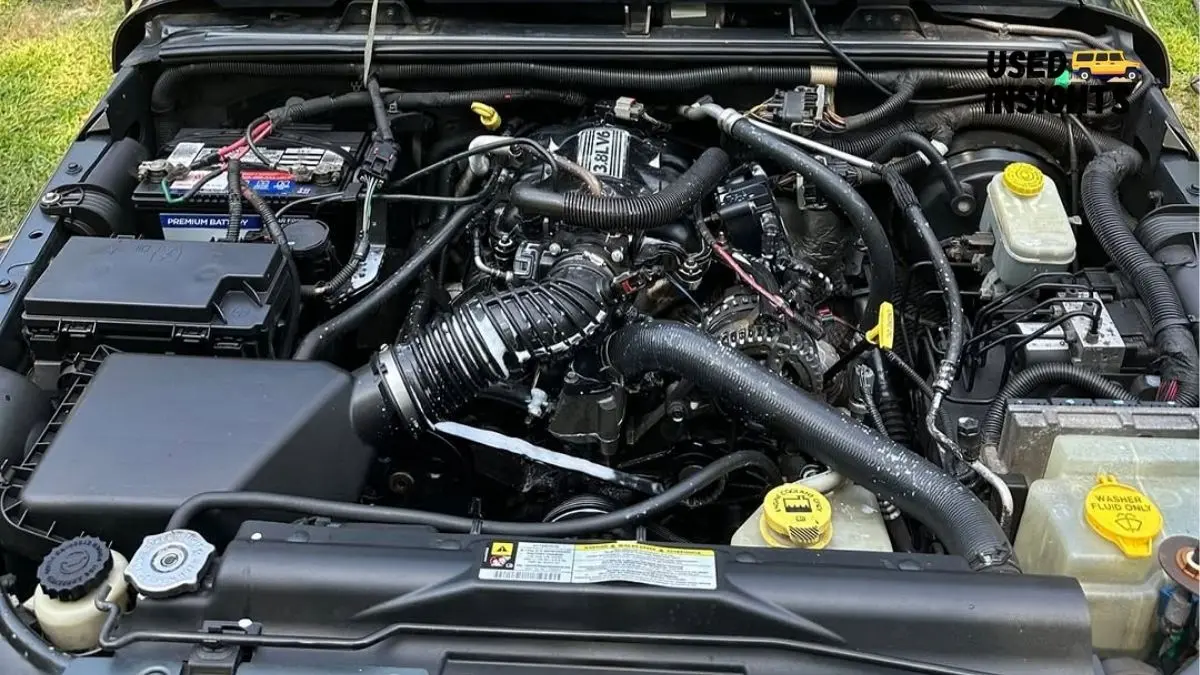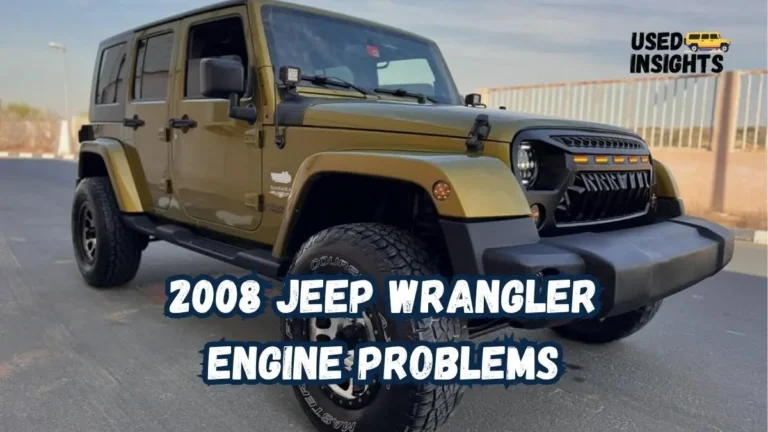The 2008 Jeep Wrangler is a beloved icon among off-road enthusiasts, known for its rugged design and go-anywhere capability. However, like any vehicle, it’s not without its flaws. Many owners have reported engine problems that can disrupt adventures and lead to costly repairs.
If you’re a 2008 Jeep Wrangler owner or considering purchasing one, understanding these issues is crucial. In this comprehensive guide, we’ll explore the most common 2008 Jeep Wrangler engine problems, their causes, solutions, and how to prevent them.
Whether you’re dealing with excessive oil consumption or a persistent check engine light, this article will equip you with the knowledge to keep your Wrangler running smoothly.
Overview of the 2008 Jeep Wrangler
The 2008 Jeep Wrangler, part of the JK generation, is powered by a 3.8L V6 engine, producing 202 horsepower and 321 lb-ft of torque. Available in models like the X, Sahara, and Rubicon, it’s celebrated for its off-road prowess and distinctive style.
However, the 3.8L engine has been a point of contention for some owners due to recurring issues that affect performance and reliability. By diving into these problems, we aim to help you diagnose, fix, and prevent engine troubles, ensuring your Wrangler remains a reliable companion on and off the trail.
Common Engine Problems in the 2008 Jeep Wrangler
The 2008 Jeep Wrangler’s 3.8L V6 engine is prone to several issues that have been widely reported by owners and documented in forums, recalls, and automotive databases like the NHTSA. Below, we outline the top engine problems, their symptoms, and their impact on vehicle performance.
1. Excessive Oil Consumption
One of the most frequently reported issues is excessive oil consumption. Owners often notice that their Wrangler burns through oil faster than expected, sometimes requiring top-offs between oil changes.
- Symptoms: Low oil levels on the dipstick, frequent need to add oil, blue smoke from the exhaust, or engine knocking.
- Impact: Low oil levels can lead to increased engine wear, reduced performance, and, in severe cases, engine failure.
- Prevalence: Common in 2008 models, especially those with high mileage (80,000+ miles).
2. Misfiring or Rough Idling
Misfiring or rough idling is another common complaint, often linked to faulty spark plugs, ignition coils, or fuel system issues.
- Symptoms: Engine stuttering, uneven idling, reduced power during acceleration, or a check engine light.
- Impact: Misfiring can cause poor fuel economy, reduced drivability, and potential damage to the catalytic converter.
- Prevalence: Reported across various mileage ranges, often tied to neglected maintenance.

3. Overheating Issues
Overheating is a significant concern for 2008 Jeep Wrangler owners, particularly those who use their vehicles for off-roading or towing.
- Symptoms: High engine temperature readings, steam from the hood, or coolant leaks.
- Impact: Overheating can damage engine components, including the head gasket, and lead to costly repairs.
- Prevalence: Common in vehicles subjected to heavy use or those with aging cooling systems.
4. Check Engine Light Issues
The check engine light (CEL) is a frequent issue, often triggered by problems with the oxygen sensors, EGR valve, or other emissions-related components.
- Symptoms: Persistent or intermittent CEL, reduced performance, or failed emissions tests.
- Impact: Ignoring the CEL can mask underlying issues, leading to more severe engine damage.
- Prevalence: Widespread, particularly in vehicles with 50,000+ miles.
5. Timing Chain or Belt Problems
The 3.8L V6 uses a timing chain, which can wear out over time, causing performance issues.
- Symptoms: Rattling noises from the engine, poor acceleration, or difficulty starting.
- Impact: A failing timing chain can lead to catastrophic engine failure if not addressed.
- Prevalence: Less common but serious, often seen in high-mileage vehicles.
Causes of 2008 Jeep Wrangler Engine Problems
Understanding the root causes of these engine issues is key to addressing them effectively. Several factors contribute to the problems outlined above:
- Design Flaws in the 3.8L V6 Engine: The 3.8L V6, while robust for off-road use, has known issues with oil consumption and timing chain durability. Some owners report that the engine’s design leads to premature wear of piston rings or valve seals, contributing to oil loss.
- Neglected Maintenance: Failure to follow a regular maintenance schedule, such as oil changes every 3,000-5,000 miles or cooling system flushes, exacerbates engine problems. Dirty oil or clogged radiators can lead to misfiring, overheating, and accelerated wear.
- Driving Conditions: The 2008 Jeep Wrangler is often used for off-roading, towing, or driving in extreme conditions. These scenarios put additional strain on the engine, leading to issues like overheating or timing chain wear.
- Component Wear: Over time, components like spark plugs, oxygen sensors, and timing chains naturally degrade, especially in high-mileage vehicles.
Diagnosing 2008 Jeep Wrangler Engine Problems
Diagnosing engine issues early can save you from costly repairs. Here’s how to identify problems in your 2008 Jeep Wrangler:
- Visual Inspection: Check for oil or coolant leaks under the vehicle, inspect belts and hoses for wear, and monitor fluid levels regularly.
- OBD-II Scanner: Use an OBD-II scanner to read diagnostic trouble codes (DTCs) when the check engine light appears. Common codes include P0300 (random misfire), P0171 (lean condition), or P0420 (catalytic converter efficiency).
- Listen for Noises: Unusual sounds like knocking, rattling, or hissing can indicate oil issues, timing chain problems, or overheating.
- Professional Assessment: For complex issues like timing chain wear or severe oil consumption, consult a certified mechanic with experience in Jeep vehicles.
If you’re not comfortable diagnosing issues yourself, a trusted mechanic can perform a comprehensive inspection, including compression tests or leak-down tests, to pinpoint the problem.
Solutions and Repairs for 2008 Jeep Wrangler Engine Problems
Addressing engine problems promptly is essential to maintaining your Wrangler’s performance. Below is a detailed table summarizing the common problems and their solutions, followed by in-depth repair strategies.
| Problem | Symptoms | Solutions | Estimated Cost |
|---|---|---|---|
| Excessive Oil Consumption | Low oil levels, blue smoke, knocking | Regular oil checks, replace piston rings/valve seals, use high-quality oil | $500-$2,000 |
| Misfiring/Rough Idling | Stuttering, poor acceleration, CEL | Replace spark plugs, ignition coils, or clean fuel injectors | $200-$600 |
| Overheating | High temp gauge, steam, coolant leaks | Flush cooling system, replace thermostat/radiator, check water pump | $300-$1,200 |
| Check Engine Light | Persistent CEL, reduced performance | Replace oxygen sensors, EGR valve, or repair wiring issues | $150-$800 |
| Timing Chain Problems | Rattling, poor acceleration, hard starts | Replace timing chain, inspect tensioners and guides | $1,000-$2,500 |
Detailed Repair Strategies
- Excessive Oil Consumption:
- Solution: Check oil levels every 1,000 miles and top off as needed. If consumption is severe, a mechanic may need to replace piston rings or valve seals, which requires partial engine disassembly. Using high-quality synthetic oil (e.g., 5W-20 as recommended by Jeep) can help reduce wear.
- Preventive Tip: Stick to a strict oil change schedule (every 3,000-5,000 miles) and use a high-mileage oil formula for older engines.
- Misfiring or Rough Idling:
- Solution: Replace spark plugs every 30,000 miles or as needed. Inspect and replace faulty ignition coils or clean fuel injectors to restore smooth operation. A mechanic may also check the fuel pump or throttle body for issues.
- Preventive Tip: Use high-quality spark plugs (e.g., NGK or Champion) and avoid low-grade fuel.
- Overheating:
- Solution: Flush the cooling system every 2-3 years to remove debris. Replace a faulty thermostat ($50-$150) or upgrade to a high-performance radiator for off-road use. Inspect the water pump for leaks or wear.
- Preventive Tip: Regularly check coolant levels and use a 50/50 mix of antifreeze and water.
- Check Engine Light:
- Solution: Use an OBD-II scanner to identify the specific code. Common fixes include replacing oxygen sensors ($100-$300) or the EGR valve ($200-$500). Ensure all wiring connections are secure.
- Preventive Tip: Address CEL issues promptly to avoid compounding problems.
- Timing Chain Problems:
- Solution: Timing chain replacement is a complex job requiring professional expertise. The chain, tensioners, and guides should be replaced together to ensure longevity.
- Preventive Tip: Listen for early signs of rattling and address them before complete failure occurs.
Preventive Tips to Avoid Engine Problems
Preventing engine issues is often easier and cheaper than fixing them. Here are actionable tips to keep your 2008 Jeep Wrangler’s engine in top shape:
- Follow a Maintenance Schedule: Change oil every 3,000-5,000 miles, replace spark plugs every 30,000 miles, and flush the cooling system every 2-3 years.
- Use Quality Parts and Fluids: Stick to manufacturer-recommended oil (5W-20 synthetic), coolant, and OEM or high-quality aftermarket parts.
- Monitor Driving Habits: Avoid excessive idling, overloading, or aggressive off-roading without proper maintenance.
- Regular Inspections: Check fluid levels, belts, and hoses monthly, especially before off-road trips.
- Address Issues Early: Don’t ignore warning signs like unusual noises, CEL, or performance changes.
Real Owner Experiences
Owner feedback provides valuable insights into the 2008 Jeep Wrangler’s engine problems. On forums like JeepForum.com and WranglerForum.com, owners frequently mention oil consumption and misfiring.
One owner shared, “My 2008 Wrangler started burning a quart of oil every 1,500 miles at 90,000 miles. Switching to synthetic oil helped, but I eventually needed a ring job.” Another reported, “The check engine light kept coming on due to a faulty O2 sensor. It was a $200 fix, but annoying.” NHTSA complaints also highlight overheating issues, particularly in vehicles used for towing or off-roading.
While these experiences reflect common issues, many owners praise the Wrangler’s durability when properly maintained. Regular upkeep and timely repairs can mitigate most problems, allowing owners to enjoy their vehicles for years.
Comparison with Other Jeep Wrangler Models
The 2008 Jeep Wrangler’s 3.8L V6 engine is less reliable than the 3.6L V6 introduced in the 2012 JK models. The newer 3.6L Pentastar engine offers improved fuel efficiency, power, and durability, with fewer reports of oil consumption or timing chain issues. However, the 2008 model’s engine is still robust for off-road use when maintained properly.
Compared to earlier TJ models (1997-2006), the 2008 Wrangler’s engine is more powerful but more prone to certain issues like oil burning.
Conclusion
The 2008 Jeep Wrangler is a capable and iconic vehicle, but its 3.8L V6 engine has its share of problems, including excessive oil consumption, misfiring, overheating, check engine light issues, and timing chain wear.
By understanding these issues, their causes, and solutions, owners can take proactive steps to maintain their Wrangler’s performance. Regular maintenance, early diagnosis, and quality repairs are key to avoiding costly breakdowns. If you’re experiencing engine problems or want to prevent them, follow the tips in this guide and consult a trusted mechanic when needed.
Have you faced any of these issues with your 2008 Jeep Wrangler? Share your experiences in the comments below!
FAQs
Q: What are the most common engine problems for the 2008 Jeep Wrangler?
A: The most common issues include excessive oil consumption, misfiring, overheating, check engine light triggers, and timing chain problems.
Q: How much does it cost to fix a 2008 Jeep Wrangler engine issue?
A: Costs vary: spark plug replacement ($200-$600), oxygen sensor replacement ($150-$300), or timing chain repair ($1,000-$2,500). Severe issues like piston ring replacement can exceed $2,000.
Q: Can I prevent engine problems in my 2008 Jeep Wrangler?
A: Yes, regular oil changes, cooling system maintenance, and using quality parts can prevent most issues. Address warning signs early to avoid major repairs.
Q: Is the 2008 Jeep Wrangler’s 3.8L engine reliable?
A: The 3.8L V6 is durable for off-road use but prone to oil consumption and other issues if not maintained properly. With regular care, it can be reliable.
Additionally, You can also like and, follow us on Pinterest, and Reddit for more updates. Your thoughts and engagement are greatly appreciated and find more info in the Jeep section!

